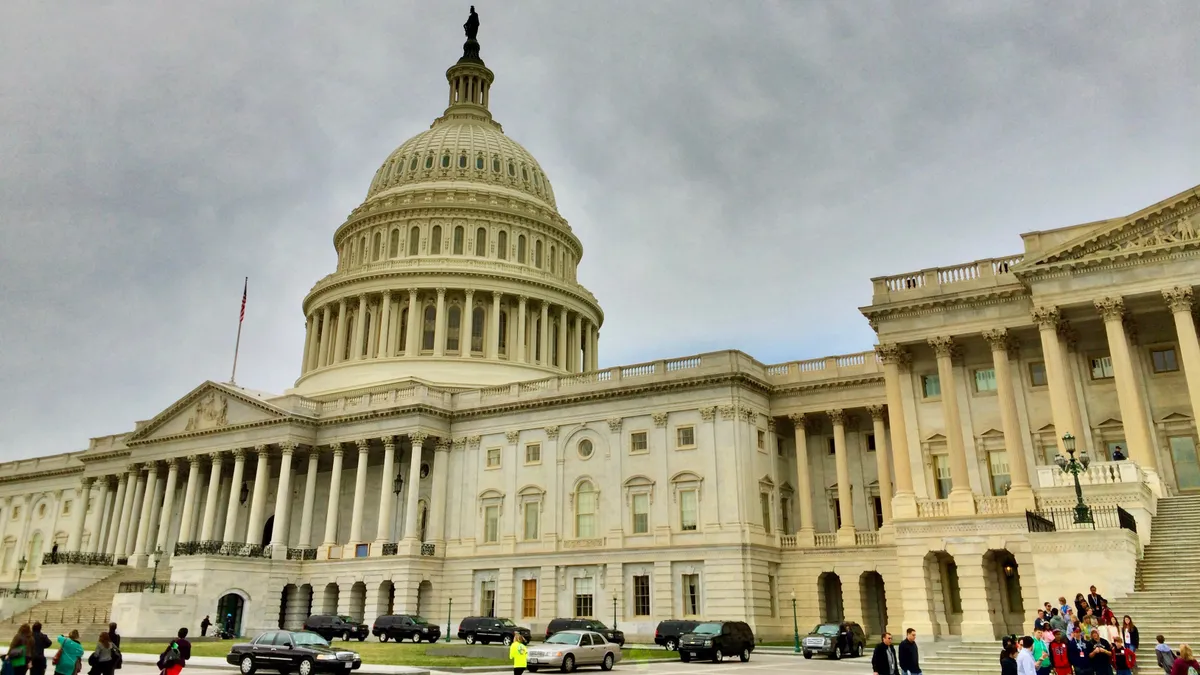Dive Brief:
- The U.S. Department of Transportation (DOT) would spend $100 billion on incentives for consumers to purchase electric vehicles (EV), as part of President Joe Biden's strategy to decarbonize the transportation sector through the American Jobs Plan, his $2.25 trillion infrastructure proposal.
- Another $25 billion would go to support electric transit vehicles; $20 billion for school bus electrification; and $15 billion to install a half million chargers across the country, according to a document published Monday, but previously reported by Reuters.
- Separately, Biden's $1.5 trillion budget request for Fiscal Year 2022, released Friday, included $600 million to electrify the federal fleet, but lacked other specifics on EVs. Experts say most of the long-term electrification investment will be made through the infrastructure bill now being developed by lawmakers.
Dive Insight:
Compared with the estimated $174 billion included for EVs in the American Jobs Plan unveiled in March, the $600 million budget request appears modest, but industry supporters expect much more over the next decade.
The Fiscal Year 2022 budget request includes funds for electric vehicles and charging infrastructure across the individual budgets of 18 federal agencies, including dedicated funds at the General Services Administration to electrify other agencies' fleets and for U.S. Postal Service charging infrastructure.
"The investment serves as a down payment to support a multiyear transformation of the Federal fleet," according to the request.
The budget request is "filling in some additional detail to what was announced as part of the American Jobs Plan," said Joe Britton, executive director of the Zero Emission Transportation Association. The group advocates for full electrification of the transportation sector.
House Speaker Nancy Pelosi, D-Calif., has targeted July 4 to finalize an infrastructure bill. Britton said he expects those efforts will center around H.R. 2, the infrastructure bill passed by Democrats in July.
The infrastructure bill passed last summer and the American Jobs Plan "are actually very close," said Britton, though Pelosi's early-July target may be "ambitious."
Congress returned to work this week following a two-week break, and infrastructure is a top priority.
Britton said he expects legislators to focus on three key policies needed to expand transportation electrification: expanding consumer incentives, rolling out charging infrastructure, and developing policies to send market signals through greenhouse gas and fuel efficiency standards.
Uncapping the 30D tax credit for electric vehicles is "crucial," said Britton. "That's an opportunity for us to really unleash consumer adoption."
The $174 billion included in the American Jobs Plan will be only a small portion of the overall money needed to transition to electric transportation, and is really "just to spur that investment," said Plug in America Executive Director Joel Levin
"It seems like a lot of money, but you're talking about completely restructuring one of the major industries of the American economy," said Levin. The "vast majority" of the spending and investment will be done by individuals and companies, he said.
Americans purchased about 14.5 million new cars last year, said Levin. So the investment proposed by the federal government would only be about 2% to 3% of what Americans will spend on cars over that time, he said.
"To put this in perspective, I think of this program as the modern day equivalent of the program to go to the moon in the 1960s," Levin said. "It was a vast and visionary undertaking that engaged much of the country. This total cost is about 60% of what it cost to go to the moon, but will pay for itself."
At this point, there are few details of Biden's transportation electrification plan, experts note. The electric vehicle sector will benefit, said Ideanomics CEO Alf Poor at the BNEF Summit on Monday, but there "is an incomplete understanding of what the benefit will be."
Ideanomics is a publicly-traded company investing in a wide swath transportation electrification technologies, including smart grid components and agricultural use cases. To support the transition to EVs, he said, a "big chunk" of infrastructure spending will need to go into utilities and the grid. But overall the spending plan is "not well defined at this point," he said.
Britton made a similar point, that some of Biden's jobs plan would tangentially support the EV transition, alongside the direct spending.
"There are other parts of the American Jobs Plan we think will accrue benefits to transportation electrification just by cultivating a strong domestic manufacturing sector," he said.
The EV sector has been excited about Biden's plans for electrification, but there have been indications that spending may ramp up slowly. In February, the Postal Service announced it would continue to purchase internal combustion engine delivery vehicles, through a 10-year contract with Oshkosh Defense.
Britton thinks of the planned federal investment in transportation electrification as an S-curve. "The more progress we make in the early years, there's more dividends in the outer years," he said.














